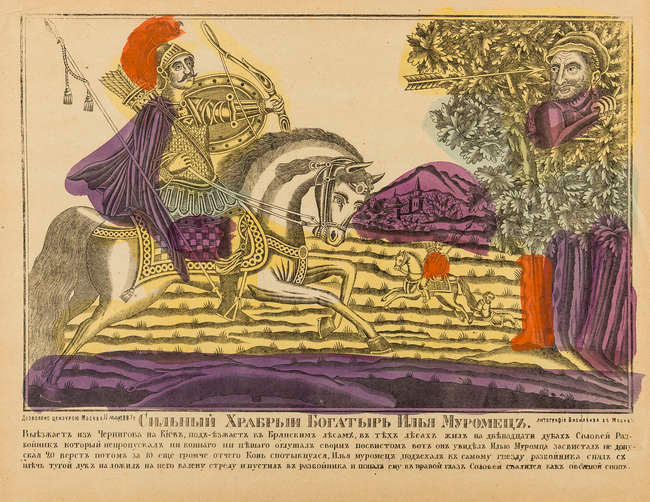Il'ia Muromets - strong and brave bogatyr & Anika - Strong, Glorious and Brave Soldier
VASIL'YEV, V.A. [printer]


Sil'nyi khrabryi bogatyr' [Il'ia Muromets. Il'ia Muromets - strong and brave bogatyr]
Moscow: V.A. Vasil'yev. c1887.
A handcoloured Lubok lithograph, printed on paper, mounted on white card, in a gold painted wooden frame. This print showing Ilya Muromets killing Solovei-Razboinik (Nightingale the Robber) who lived in the forests of Bryansk where he lured travellers to their death. In Russian legend, Ilya Muromets is a Bogatyr, that group of heroic warrior knights whose principal duty was to protect Russia against foreign invasion. He features in the epic folkloric poems known as byliny where we learn that, as a child, Ilya suffered from an illness that left him unable to walk until he was miraculously cured at the age of 33 and given colossal strength which he used to liberate Kiev, defend Chemigov from invasion and, as we see here, dispose of evil monsters.
This striking image is a fine example of a Lubok print, a distinctively Russian type of popular art which uses simple images in the naive style, to represent stories from myth, legend, history (especially military), literature and religion, often with a strongly nationalistic theme. They could be cheaply reproduced and so were widely printed and distributed. Although they are found uncoloured, one of the most charming aspects of lubki prints is the use of bright, dramatic colours such as the vivid yellow, red and purple in this print of Ilya firing the arrow that is about to kill Solovei-Razboinik.
Sold together with:
Sil'nyi i slavnyi kharbryi oin Anika. [Anika - Strong, Glorious and Brave Soldier]
A handcoloured Lubok lithograph, printed on paper, mounted on white card, in a gold painted wooden frame. This print shows Anika the Warrior engaged in a battle against death. In Russian legend, Anika is a Bogatyr, that group of heroic warrior knights whose principal duty was to protect Russia against foreign invasion. Anika was something of a loose cannon, as he is best known for planning to destroy the Holy Sepulchre in Jerusalem (believed to be the site of Jesus's Crucifixion and Burial). On his way, Anika is challenged by the figure of Death in disguise who defeats him.
This striking image is a fine example of a Lubok print, a distinctively Russian type of popular art which uses simple images in the naive style, to represent stories from myth, legend, history (especially military), literature and religion, often with a strongly nationalistic theme. They could be cheaply reproduced and so were widely printed and distributed. Although they are found uncoloured, one of the most charming aspects of lubki prints is the use of bright, dramatic colours such as the vivid yellow, red and purple in this print of Anika about to meet his end.
Sold as a pair for £750
